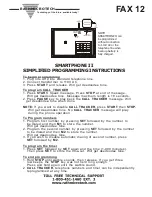
Design Guide for the Alcatel
OmniPCX
Enterprise – Mobile IP Touch
Number of Simultaneous Voice Calls
Available Bandwidth for IEEE 802.11g
*14 0
12 0.32
Mbps
10 2.38
Mbps
6 7.37
Mbps
2 11.80
Mbps
* Not possible with any potential concurrent data traffic.
•
Voice on 802.11b, Data on 802.11a
Because IEEE 802.11a utilizes the 5 GHz wireless spectrum, it offers no direct radio competition to VoWLAN
solutions that require use of the 2.4 GHz IEEE 802.11b realm. This is an ideal situation that offers the
greatest benefit for both voice and data subscribers.
As a result of the lack of frequency competition, VoWLAN elements are free to utilize the full theoretical 11
Mbps (less overhead and signaling) of the IEEE 802.11b network. Congestion and competition is reduced or
eliminated, resulting in the highest possible levels of service and voice quality.
This full separation of networks is also of great advantage to data subscribers, as the bandwidth hungry
applications found on data clients can gain access to the full theoretical 54 Mbps of IEEE 802.11a
technology, as well as benefit greatly from the density and coverage capabilities of the 10-13 non-
overlapping channels (depending on local market restrictions) it makes available.
Customers seeking this type of solution can unify the infrastructure elements by using Alcatel’s OmniAccess
product suite for both Wi-Fi formats. Alcatel’s OmniAccess 70 Access Point can be effectively leveraged to
construct networks for both 2.4 GHz (802.11b/g) and 5 GHz (802.11a) networks simultaneously. For more
detailed product information, visit
http://www.alcatel.com/enterprise/en
.
•
Partially Overlapping Voice and Data Networks on 802.11b/g (isolated applicability)
In some cases, a customer may implement IEEE 802.11b for voice and choose to restrict Wi-Fi data client
access for security or productivity reasons. This same customer may decide that Wi-Fi data access is
desirable in very specific and isolated environments (a shipping dock, cafeteria, large auditorium, etc.) For
cost control and access flexibility the customer may desire to service these isolated data applications with IEEE
802.11b. This can present channel overlap challenges.
Similar situations can be encountered when a customer network closely neighbors another Wi-Fi
environment. Hot-Spots, Cyber Café, or Wi-Fi radio propagation from the building across the street can all
present direct channel competition.
Due to the distinct channel selection options available, with careful planning it is usually possible to adapt to
these types of network settings. Care must be taken to ensure that the data environment does not pose
significant impact to the voice solution.
ESD/ Central Pre Sales / DF/ JM
23/34
June 2005 – Ed 01












































